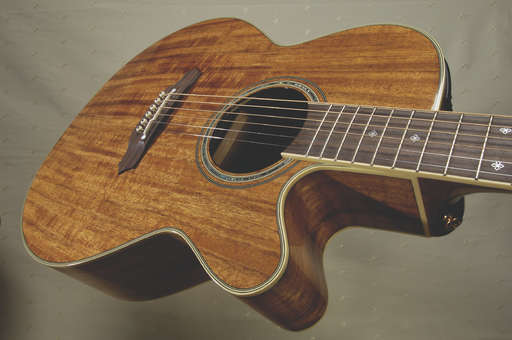MusicRadar Verdict
This guitar is an outright delight and we'd happily own it - in fact, it's one of the nicest Takamines we've tried in a long while!
Pros
- +
An impressive performer!
Cons
- -
Very oblique view of preamp, but that's the Takamine way…
MusicRadar's got your back
Much of Takamine's focus this year has centred on the company's budget models, many of which are now being sourced from China rather than Korea.
However, the brand's core business - in prestige terms if not quantity - continues to be its Japanese-made instruments, now being produced in a recently opened state-of-the-art factory.
Our review electro is an example of this new facility's workmanship and a debut to boot.
Overview
The body is all koa, while the cream-edged purflings front and back are more elaborate, the soundhole rosette sports an abalone inlay, and the sculpted-profile bridge has the split saddles that Takamine tends to reserve for its more upmarket instruments.
At nearly £900, albeit including a good-quality hard case, it may be mildly surprising to learn that the body is laminated, but such is the cost and increasing scarcity of this beautiful, golden-hued Hawaiian timber that even with a solid top, let alone all-solid construction, the guitar would command a rather more exalted asking price.
As it stands, it's a darn pretty instrument to behold, with a fair amount of lateral figuring dotted around the outermost veneers.
It's not just the EF508KC's body that receives the more deluxe treatment.
The rosewood fingerboard carries outline-snowflake markers and is bound in body-matching cream plastic, which continues up around the rosewood-faced headstock where the tuners are gold rather than chrome plated.
The style of binding gives a slightly more abrupt edged feel to the (again slender yet deepish) neck, but the fretting and set-up is of a high standard.
Sounds
The EF508KC is an impressive, likeable acoustic performer.
There's possibly a shade more underlying warmth in the mids and low end, and a sense of slightly stronger projection, but these are very subtle differences and you'd need to be blessed with a keen ear to tell them apart with certainty in a blind test.
Likewise when the CT4BII is fired up. The comparative nuances become even more finely shaded, and it's more than likely that you'd find yourself using near-identical backline and onboard EQ settings whichever of the two instruments you were playing. There's consistency for you.
As far as perceived value is concerned, the one disadvantage Takamine has with this debut is that it might seem expensive compared to other electros that offer all-solid construction for less money.
The reality is that for the important criteria of build, playing enjoyment and sound, it comfortably justifies its price point.

Proggy pentatonic! How to use the good ol’ pentatonic scale in cool new ways

“George is certainly not a rock player, and neither is Ringo. They’re both swing musicians”: Producer T Bone Burnett on the country roots of the Beatles

“Thanks to all those that have enjoyed it without understanding it”: Rage Against the Machine's most controversial track exceeds a billion streams
Most Popular









